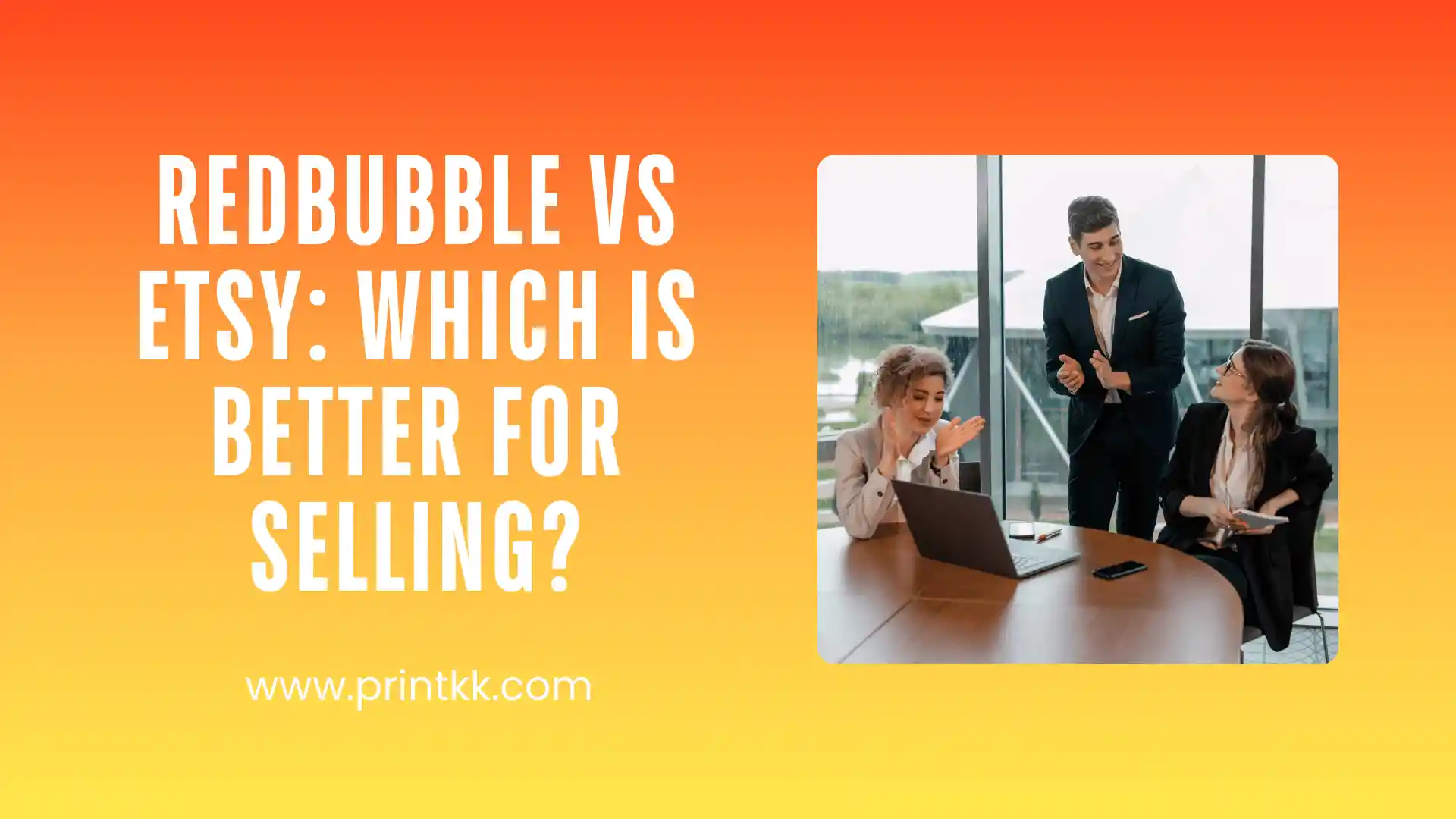
In the ever-evolving world of online sales, the dilemma between choosing Redbubble or Etsy for selling in 2025 remains a critical decision for artists, designers, and entrepreneurs. Both platforms offer unique opportunities and challenges, leaving many questioning which is the better choice for maximizing profits and audience reach. This blog delves deep into the nuances of both Redbubble and Etsy, comparing their features, benefits, and drawbacks to help you make an informed decision that aligns with your business goals and creative aspirations.
Of course, if you can't wait to get to know the huge number of high-quality custom products, join PrintKK now and enjoy the personalized experience! Get our exclusive $5 coupon and save on your first order!

Introduction
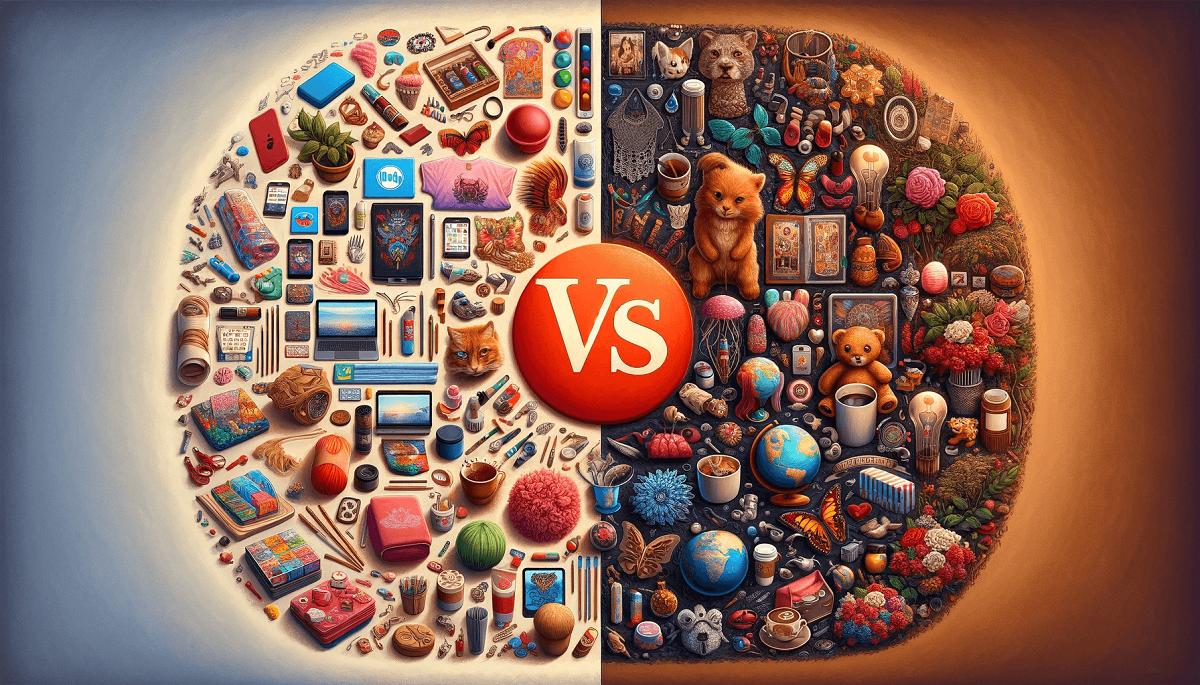
In the bustling realm of online commerce, Redbubble and Etsy emerge as two distinct havens for creators and shoppers alike. Redbubble, since 2006, has carved out a niche for over 800,000 artists, yielding a marketplace revenue of $467.5 million and artist earnings of $91 million, according to eComBusinessHub. This platform is a testament to the power of print-on-demand, connecting a global community of independent creators with a vast customer base.
Meanwhile, Etsy's artisanal charm attracts those who cherish the handmade and vintage, with a community of 7.3 million sellers reported by Business of Apps. Unlike Redbubble's print-focused model, Etsy's marketplace is a trove of unique, often handcrafted goods, appealing to a clientele that values the personal touch.
Choosing between Redbubble's print-on-demand diversity and Etsy's handcrafted marketplace is a strategic decision for entrepreneurs. Each platform offers a unique environment tailored to different creative expressions and business models, making the choice dependent on one's artistic direction and audience.
What Is Redbubble?
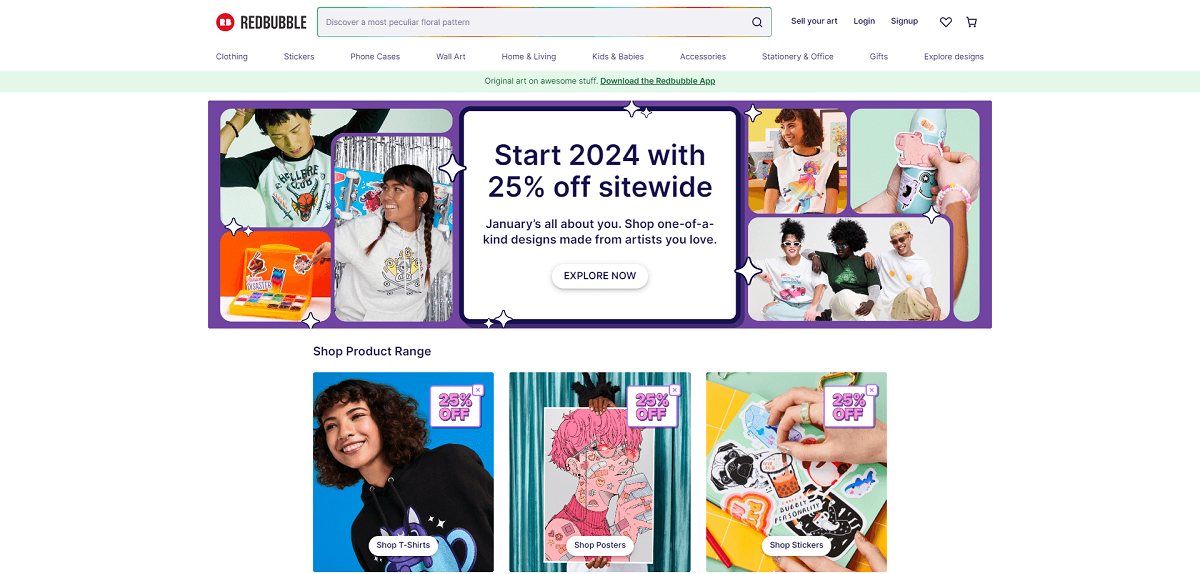
In the vibrant landscape of print-on-demand (POD) platforms, Redbubble emerges as a distinct and innovative player. Founded in 2006 in Melbourne, Australia, Redbubble has grown into a global community where creativity and commerce intersect. This platform is not just a marketplace; it's a thriving ecosystem that supports over 800,000 independent artists. These creative minds upload their unique designs, transforming them into a variety of products, from clothing and stickers to home decor and accessories.
What sets Redbubble apart is its artist-centric approach. Artists have the liberty to set their own margins, offering them control over their earnings. The platform's structure is designed to ensure that artists are compensated for every sale, fostering an environment where creativity is not just encouraged but also rewarded. This has led to a diverse array of artwork, catering to a wide range of tastes and preferences.
Redbubble's commitment to artists and customers alike has positioned it as a leading POD platform. It's not just a site for buying and selling; it's a community where art is celebrated, shared, and appreciated. For entrepreneurs, small business owners, designers, and artists, Redbubble offers a unique opportunity to engage with a global audience, showcase creativity, and build a brand. Whether you're an established artist or a budding designer, Redbubble provides a canvas to bring your ideas to life and a marketplace to share them with the world.
How Redbubble Works?
Redbubble, a platform celebrated for its print-on-demand services, operates through a model that is both simple and ingenious. Artists globally are invited to share their unique artworks on Redbubble. They upload their designs and can then select from various products to feature their art.
Once a customer purchases an item, Redbubble takes care of the production, shipping, and customer service. The artists earn a commission for each sale, with the ability to set their own profit margins. This approach not only facilitates artists in selling their work effortlessly but also offers customers a wide range of original products. For entrepreneurs and creatives, Redbubble opens doors to global markets and diverse audiences.
Pros and Cons of Redbubble
Pros
- Wide Artist Base
Over 800,000 artists contribute diverse and unique designs.
- Product Variety
Offers a vast range of products for artists to print on.
- Artist Control over Pricing
Artists set their own profit margins.
- Global Reach
Access to a worldwide customer base.
- Ease of Use
Simple platform for uploading and managing designs.
Cons
- Competition
High number of artists leads to increased competition.
- Limited Customization for Buyers
Buyers have fewer customization options compared to some other platforms.
- Royalty Rates
Some artists may find the base royalty rate lower than desired.
- Market Saturation
Popular designs can become oversaturated quickly.
What Is Etsy?
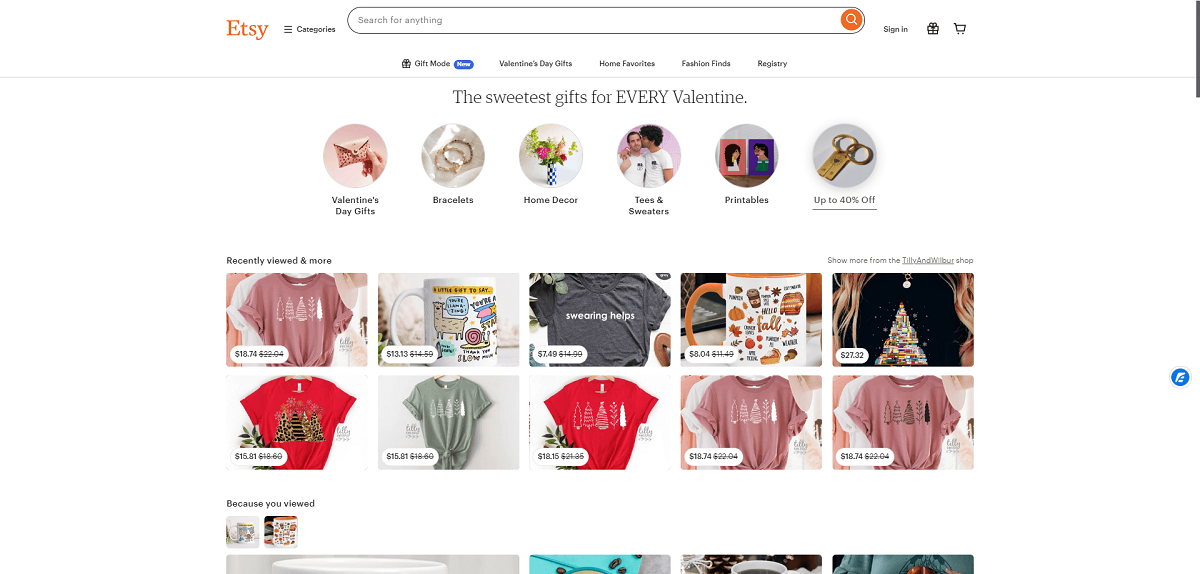
Etsy has carved out a unique niche in the e-commerce landscape, celebrating the distinctiveness of handmade, vintage, and artisanal goods. Since its inception in 2005, the platform has grown into a global community that brings together artisans, small business owners, and vintage enthusiasts. Its allure is rooted in a commitment to the individuality and craftsmanship of its items, which range from bespoke jewelry to tailor-made furniture.
For entrepreneurs and creatives, Etsy provides a supportive environment that's conducive to showcasing and selling one-of-a-kind products. The platform not only bridges the gap between skilled artisans and an international audience but also cultivates a community that appreciates the narrative and artistry of each piece. It's this dedication to the personal touch and the stories behind the products that makes Etsy the go-to hub for unique, handcrafted items.
How Etsy Works?
Etsy serves as a distinctive e-commerce stage for independent vendors and craftspeople to display and vend their unique, handcrafted, and vintage treasures. It empowers creators by providing the tools to establish personal storefronts within the larger Etsy ecosystem. This model allows sellers to preserve their individual brand identities while accessing a broad, international customer base.
The platform simplifies the selling process: artisans create their shop, curate their product listings with detailed narratives and visuals, and engage directly with the consumer base. Etsy streamlines the transactional aspect, offering a variety of payment methods to ensure a seamless exchange. This environment is especially attractive to small business proprietors, designers, and artists yearning to immerse themselves in a marketplace that values and seeks out the exclusivity and craftsmanship of handcrafted goods.
Pros and Cons of Etsy
Pros
Unique Product Range Etsy's focus on handmade, vintage, and custom items creates a unique shopping experience.
Strong Community Connection Etsy's platform fosters a strong sense of community among artisans and buyers.
Personalized Stores Sellers can create personalized storefronts to showcase their unique brand.
Niche Market Appeal Etsy appeals to customers looking for unique, non-mass-produced items.
Support for Small Businesses Etsy provides a platform for small businesses and individual artisans to reach a global audience.
Cons
Fee Structure Sellers face listing fees, transaction fees, and payment processing fees.
Intense Competition The popularity of Etsy leads to high competition among sellers.
SEO and Marketing Dependency Success on Etsy often requires strong SEO and marketing skills.
Limited Product Categories Etsy's focus on certain types of products can limit seller offerings.
Customer Expectations High customer expectations for customization and craftsmanship can be challenging for sellers.
Redbubble vs Etsy: Similarities
Platform for Independent Creators Both platforms provide a space for independent artists and creators to sell their unique designs.
Global Customer Base Redbubble and Etsy cater to a global audience, offering wide market exposure.
Product Diversity Each platform offers a variety of products, from apparel to home decor.
Artist and Seller Empowerment They empower artists and sellers to build a brand and directly connect with customers.
Community Focus Both prioritize building a community around art, creativity, and unique products.
Redbubble vs Etsy: Platform Differences
Product Types
Redbubble offers a diverse range of print-on-demand products, ideal for artists focusing on graphic designs. Etsy, in contrast, caters to handmade, vintage, and unique custom products, providing a broader scope for artisans and crafters.
Platform Support
Redbubble provides a straightforward platform for artists to upload designs, while Etsy offers more comprehensive tools for managing an entire online store, including customization of the storefront.
Fees and Pricing
Etsy charges listing and transaction fees, impacting the overall pricing strategy of sellers. Redbubble, on the other hand, operates on a commission basis, where artists earn a margin over the base price.
Payment Methods
Both platforms offer multiple payment options, including major credit cards and PayPal. Etsy also includes Etsy Payments, its own payment processing service.
Integrations
Etsy allows integration with various e-commerce tools and platforms, such as PrintKK, for enhanced store management, streamlining the process from design to production. Redbubble's integrations are more focused on design and production aspects.
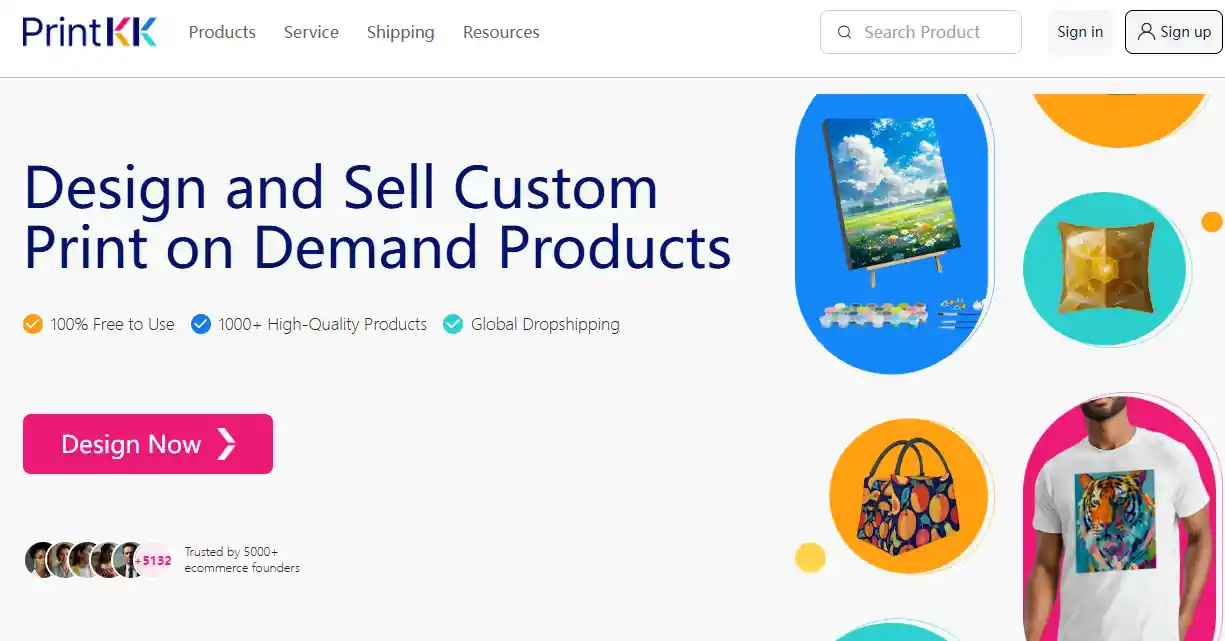
Shipping and Delivery
Redbubble handles shipping and delivery, providing a hassle-free experience for artists. Etsy sellers manage their own shipping, offering more control but also more responsibility.
Customer Service
Etsy's customer service is more direct, involving interaction between buyers and sellers. Redbubble provides centralized customer service, handling inquiries and issues related to orders.
Is Etsy or Redbubble Better for Selling?
In the quest to determine the most effective platform for selling unique and creative goods, many entrepreneurs and artists find themselves weighing the benefits of Etsy against those of Redbubble. To gain a clearer understanding of which marketplace might better serve their business needs, we've delved into the depths of the internet, gathering authentic feedback from various users across popular forums such as Quora and Reddit. These insights, drawn from the experiences of real sellers, aim to shed light on the topic "Is Etsy or Redbubble Better for Selling?" and provide valuable perspectives to those standing at the crossroads of this decision.
Insights from Seasoned Sellers
- Ease of Use and Investment
Redbubble requires no initial investment and handles manufacturing and shipping, making it user-friendly for sellers who prefer to focus solely on design.
- Profit Margins and Sales Process
Etsy sellers manage manufacturing and shipping, offering greater control over the sales process but also higher responsibilities and costs.
- Market Saturation and Competition
Both platforms face market saturation, with Redbubble particularly noted for lower profits on certain items like stickers.
- Customer Reach and Branding
Etsy is recognized for its ability to build a stronger brand presence and connect personally with customers, though it involves fees for listing and sales.
- Platform-Specific Challenges
Redbubble faces criticism for inconsistent policies on fan art, while Etsy's fees and intense competition pose challenges for new sellers.
- Revenue and Payment Thresholds
Sellers on Redbubble must reach a minimum earnings threshold before payout, while Etsy offers more immediate payment options.
User Reviews (Selected Excerpts)
Dame_Neamhain:
I've been on RedBubble since 2013. I used to make at least $30 to $50 a month for several years. Now I'm lucky if I make $20 in 6 months. RB is basically dead, I would try a different PoD site. I really wouldn't recommend Etsy though, cause their fees are absolutely bonkers. Also, a LOT of PoD sites are over-saturated now, due a lot to the whole "cReAtE A pAsSiVe InCoMe StReAm!!1!!!1 EaSy MoNeY, bUy mY cOuRsE tO geT sTarTed!!1!!" dumbasses. -_- Oh and the literal droves of bots that are slowly infesting every site on the internet.
ibanvdz:
Redbubble does not require any investment from you. You only need to upload quality images and take care of positioning on products that require so. You set your profit margin for every product (or just go with the default setting). The only additional thing you need to do is guide traffic to your shop, but that's no different from Etsy. Everything else is done by RB.
They outsource printing to a printer nearest to the customer to reduce shipping. RB deals with the customers, shipping, damage, returns,... I see Etsy for sellers who sell small/cheap originals, not for products that can be made through POD. They ask for a listing fee AND a sales fee, and on top of that you have to ship yourself (with all risk involved). A lot of hassle for the minor profit to be made on stickers.
Artlearninandchurnin:
I sell on both I have a shop and can customize my etsy a lot better than redbubble. I made my own stickers and get around $3 profit per sticker I sold the same stickers on redbubble for a higher price and made 10 cents per sticker.. and on redbubble, I cannot be paid until I hit a $20 minimum. Etsy I get paid daily.
James Reid:
Print on Demand sites like, Society6 and Redbubble handle the shipping, customer service, returns, etc. for you. You only have to upload your designs to their site. Rebubble is much easier to upload artwork on and allows you to make adjustments on each product and even lets you pattern those designs on the products. Society6 is similar, but you have more specific size requirements for each product you want to enable, so it takes a little more time to get your products set up. Both have a similar commission rate and you will get 10–20% of the profits for each sale.
This is not the option for any one starting up to being able to quit your day job. Etsy has it's advantages and you can make more profits with each sale, but you have to put more effort in the creation of your products. I tell everyone wondering where to start: Use the classic Print on Demand sites first, and then use Etsy once you are confident to looking into drop shipping options or local print shops to get your products created.
Alternatives to Etsy and Redbubble
Shopify
Ideal for establishing a personalized online store with extensive customization options.
Zazzle
Offers a similar print-on-demand model with a focus on customized gifts and products.
Society6
Known for its high-quality art prints and unique home decor items.
Big Cartel
Caters specifically to artists and makers, providing tools to build an independent brand.
Teepublic
Similar to Redbubble, focuses on apparel and offers competitive artist margins.
Amazon Handmade
Targets artisans looking to tap into Amazon's vast customer base.
Conclusion
In conclusion, choosing between Redbubble and Etsy largely depends on individual preferences and objectives. Redbubble is ideal for those seeking a hassle-free, print-on-demand solution, focusing on design. Etsy, conversely, is better for selling unique, handmade items, offering greater branding control but needing more involvement in logistics. Each platform has distinct strengths, and the choice should align with your business model and creative aspirations.
FAQs
Is it hard to sell on Redbubble?
Selling on Redbubble demands strategy; success hinges on unique designs and marketing savvy. With Redbubble managing production, sellers must focus on SEO, social media, and branding to stand out and attract customers in a competitive market.
What type of art sells best on Redbubble?
Trending, original designs with a pop culture twist lead sales on Redbubble. Successful pieces resonate widely, blend humor with the modern zeitgeist, and adapt across products like tees or cases. Staying current and evolving artistically are key.
What is the most profitable art on Etsy?
On Etsy, personalized art like custom portraits and bespoke stationery leads in profitability. Unique, customizable items command higher prices. Digital downloads also offer substantial margins with minimal overhead.
Can I link Redbubble to Etsy?
Linking Redbubble with Etsy isn't built-in, yet you can use both to expand reach. Promote your Redbubble in your Etsy description or profile, combining Etsy's custom market with Redbubble's print-on-demand.










 Global Shipping
Global Shipping




























